An Analysis of Vietnamese EFL Students’ Pronunciation of English Affricates and Nasals
English learners in Vietnam may have many difficulties when pronouncing English, mainly Nasals and Affricates
since English has been their second most used language. There are many factors which lead to this problem like
their mother tongue, their study environment, and a lack of knowledge about English phonology and phonetics.
This assignment analyzes the problems in English’s Affricates and Nasals pronunciations experienced by
Vietnamese EFL students. Data were collected and analyzed from many Vietnamese students including tips and
techniques to improve each different pronunciation of Affricates and Nasals. This research will hopefully widen
knowledge for those who want to improve their pronunciation of Affricates and Nasals and establish more
information which could be able to be developed in the English phonology and phonetics systems in Vietnam.
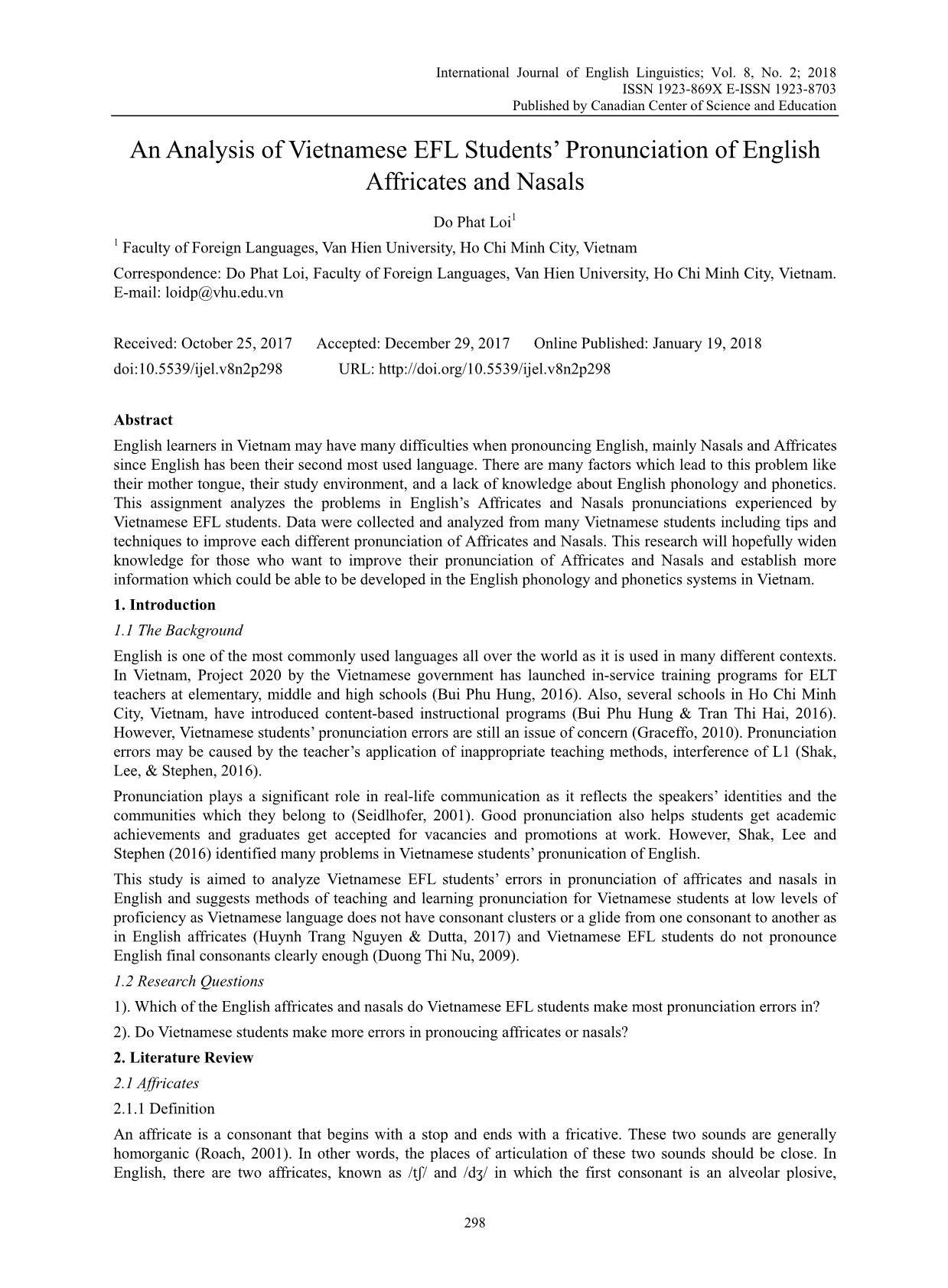
Trang 1
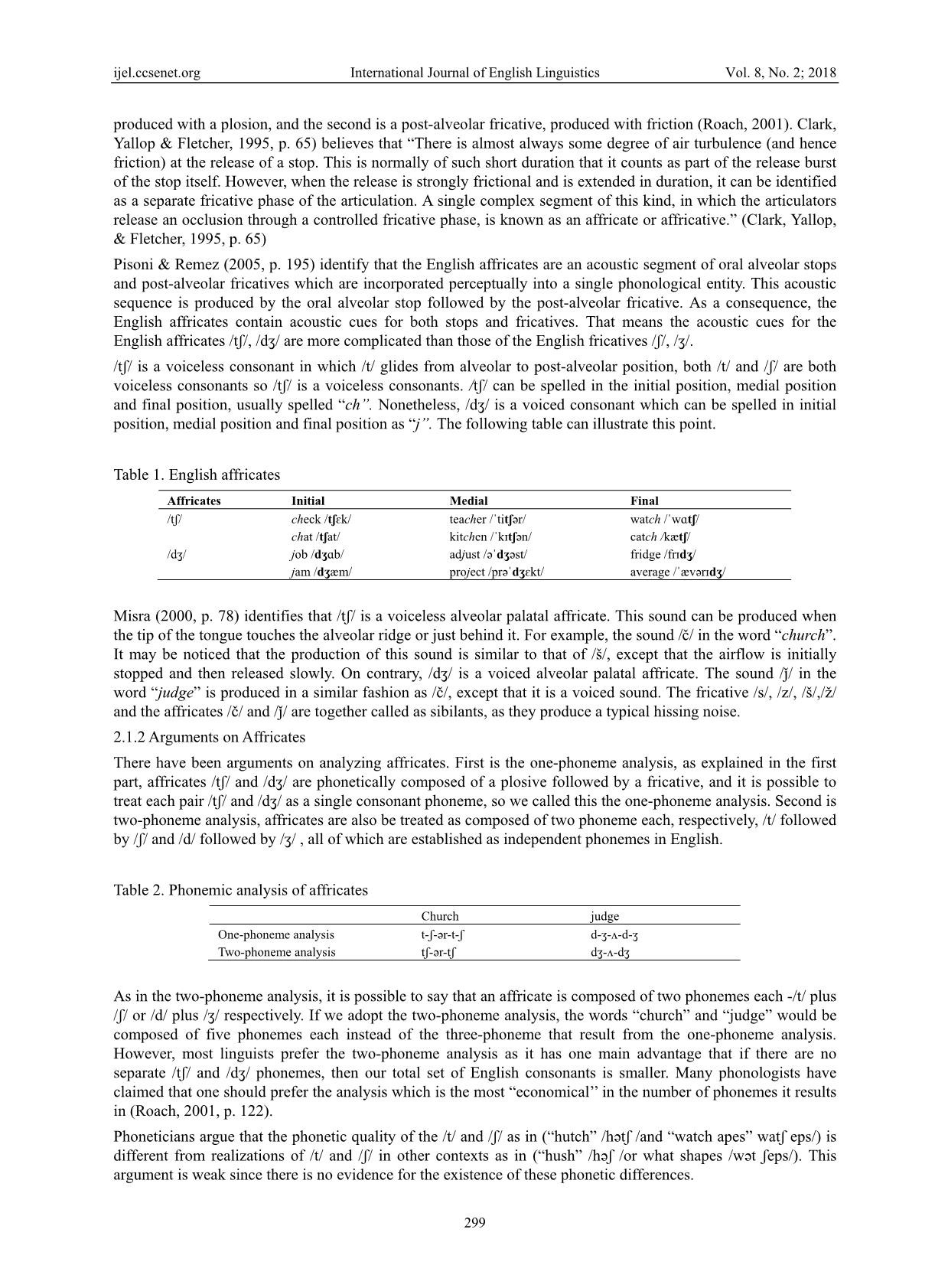
Trang 2
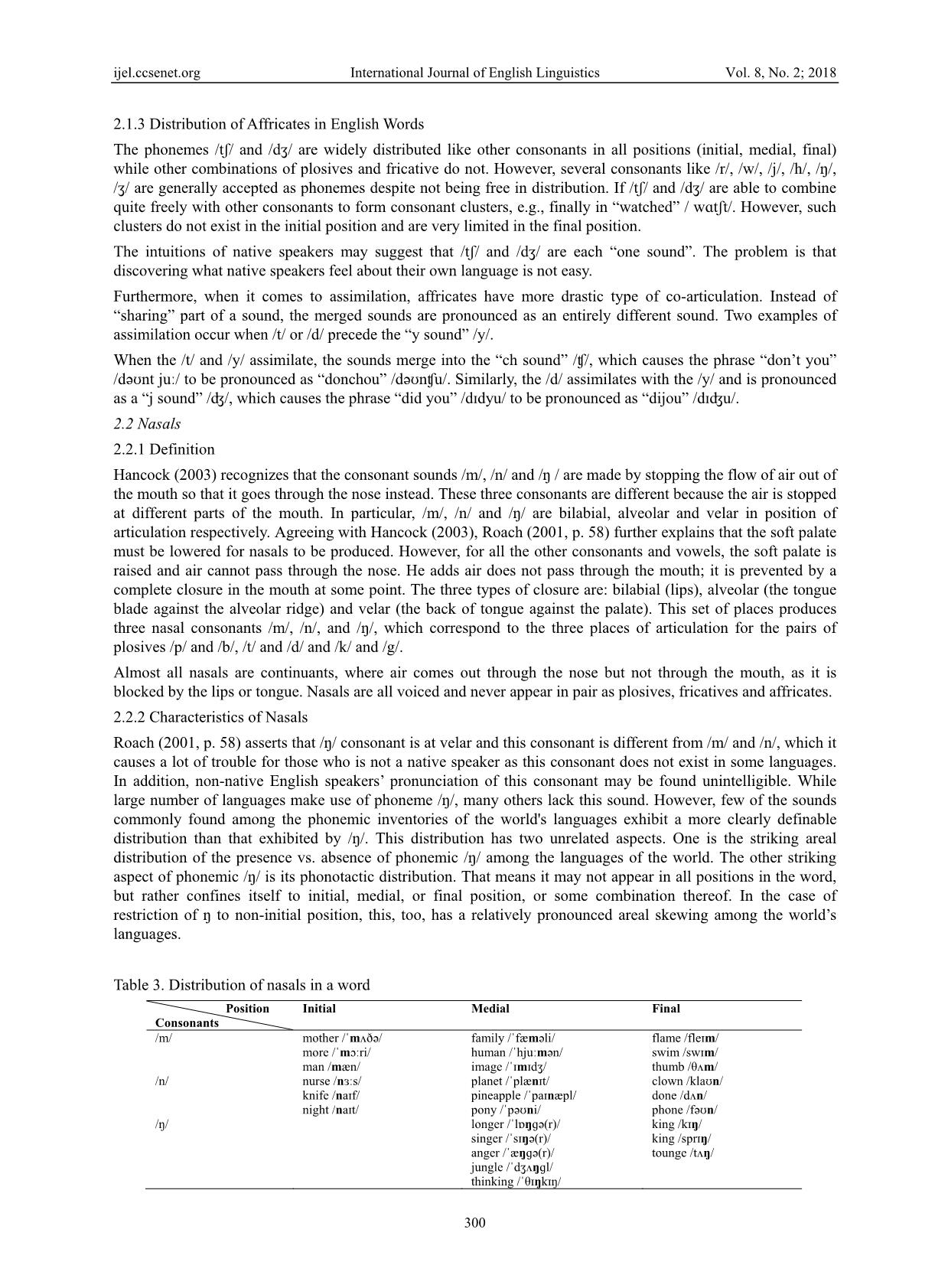
Trang 3
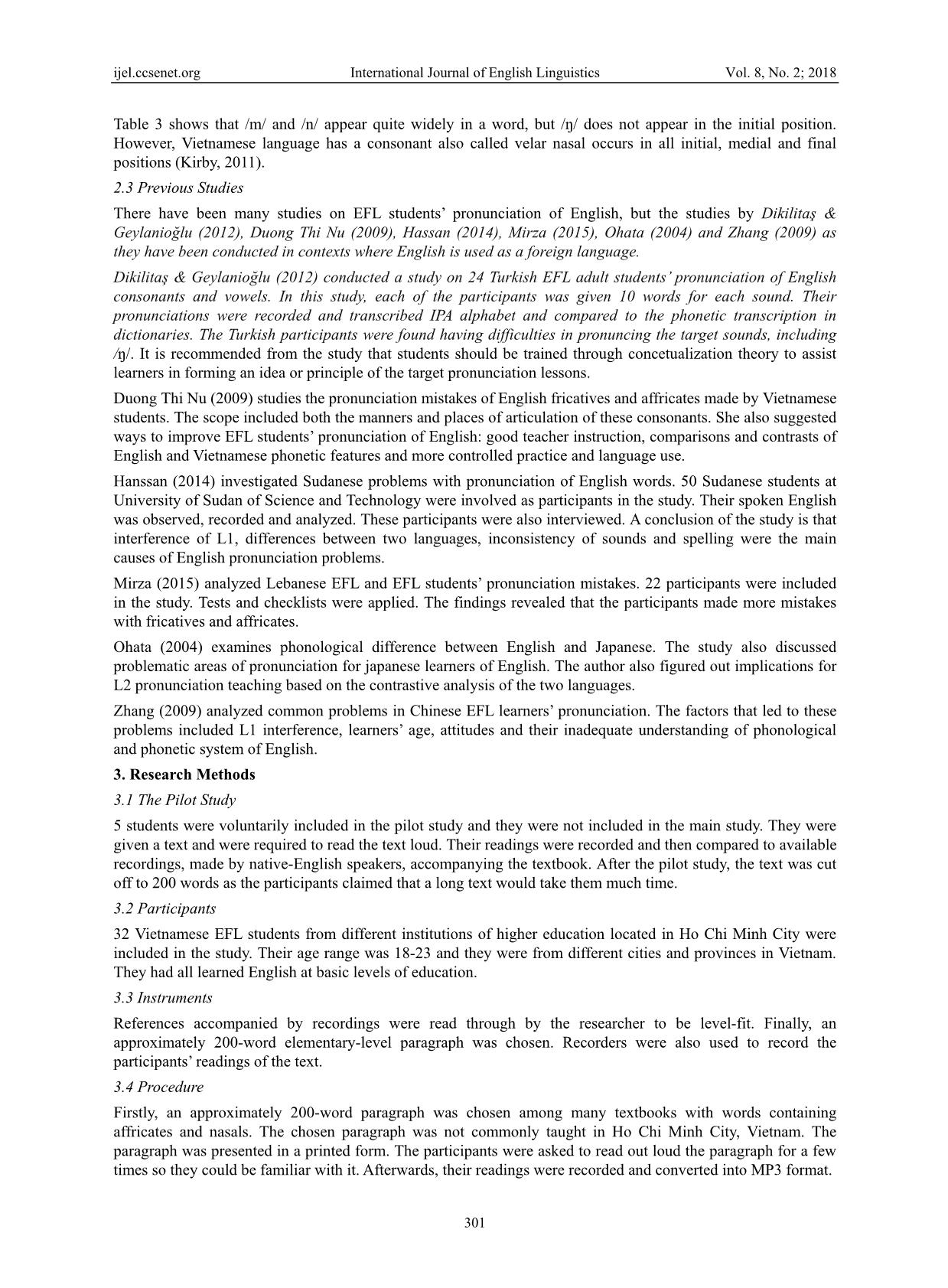
Trang 4
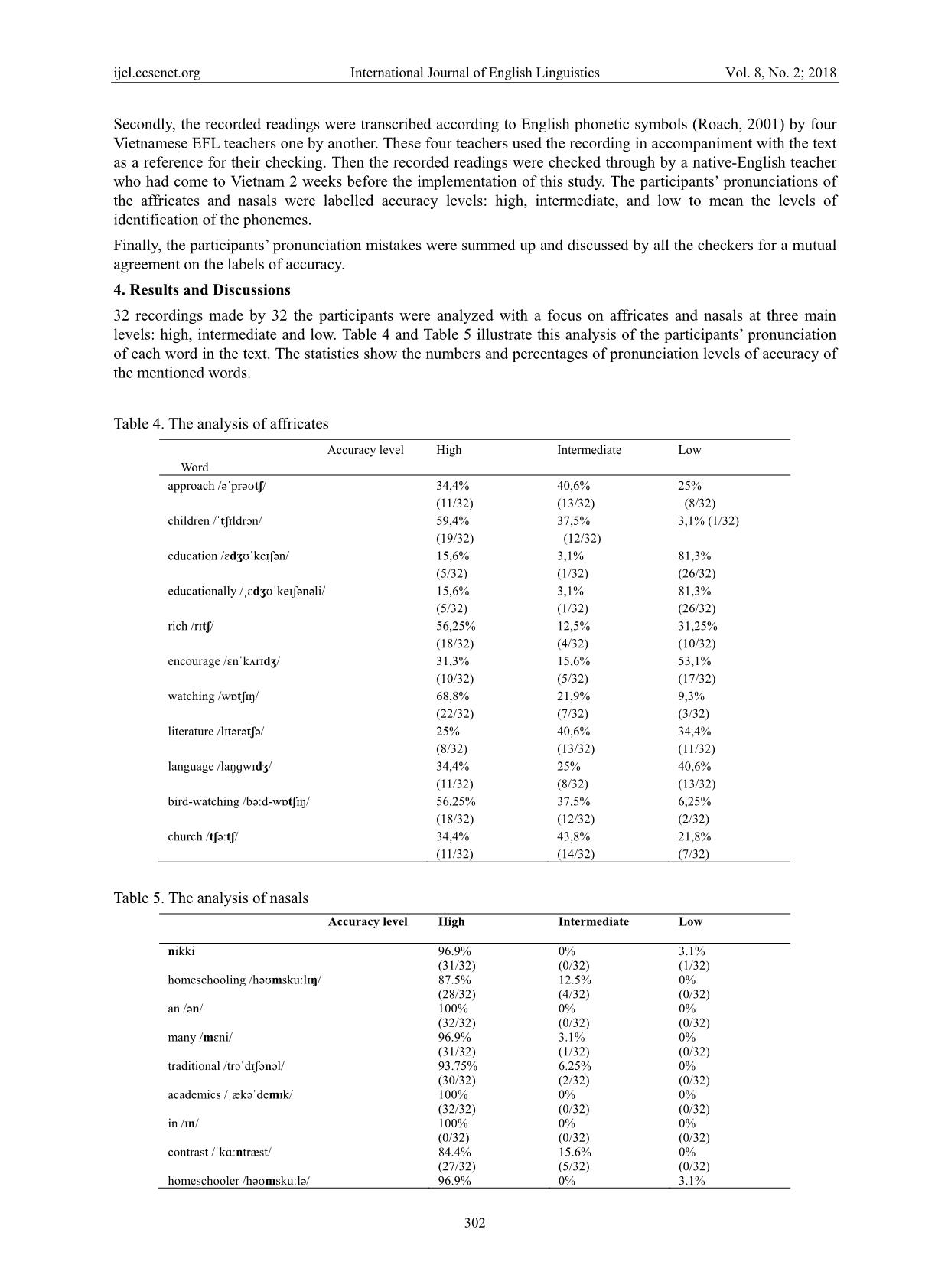
Trang 5

Trang 6
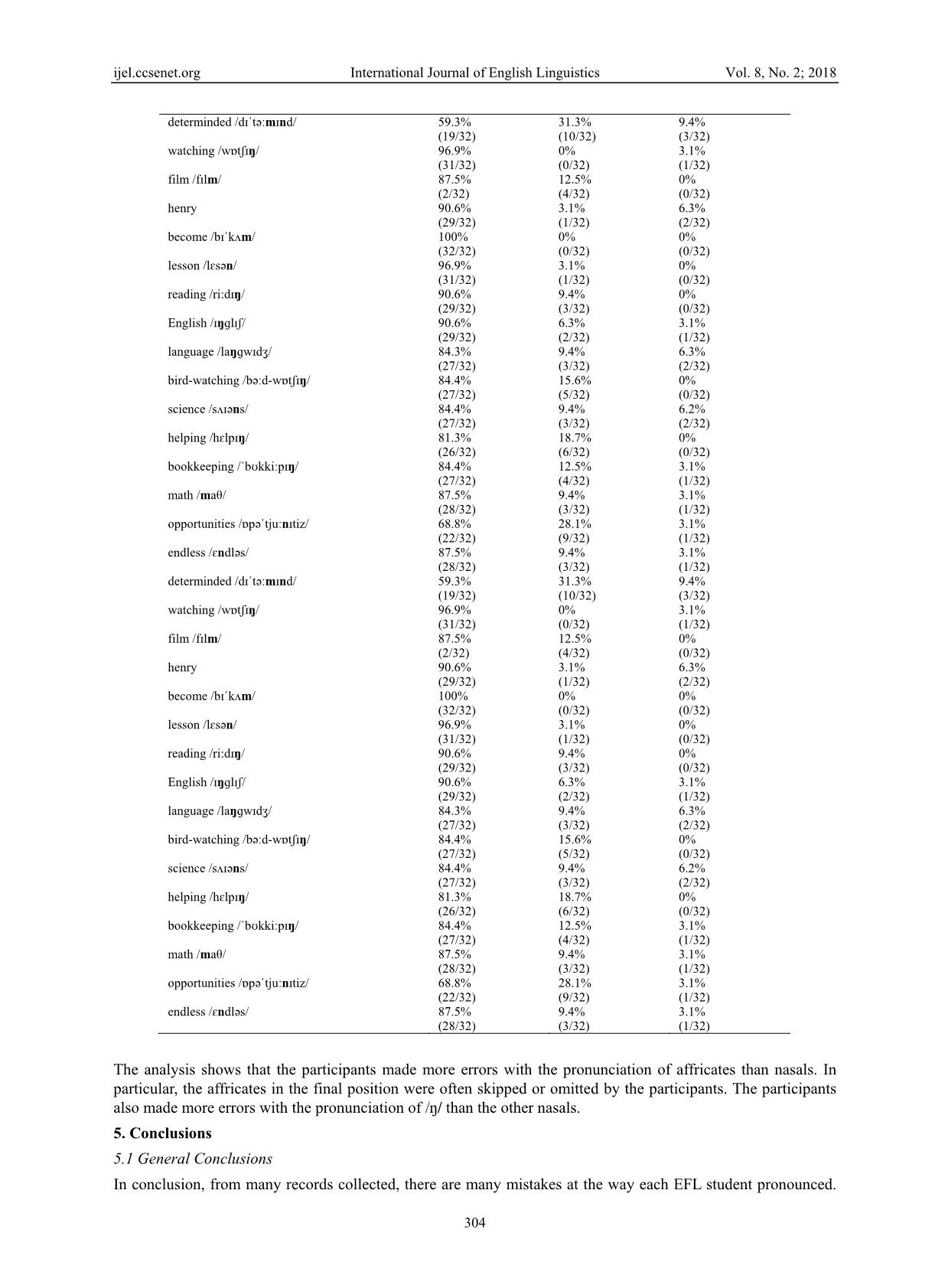
Trang 7
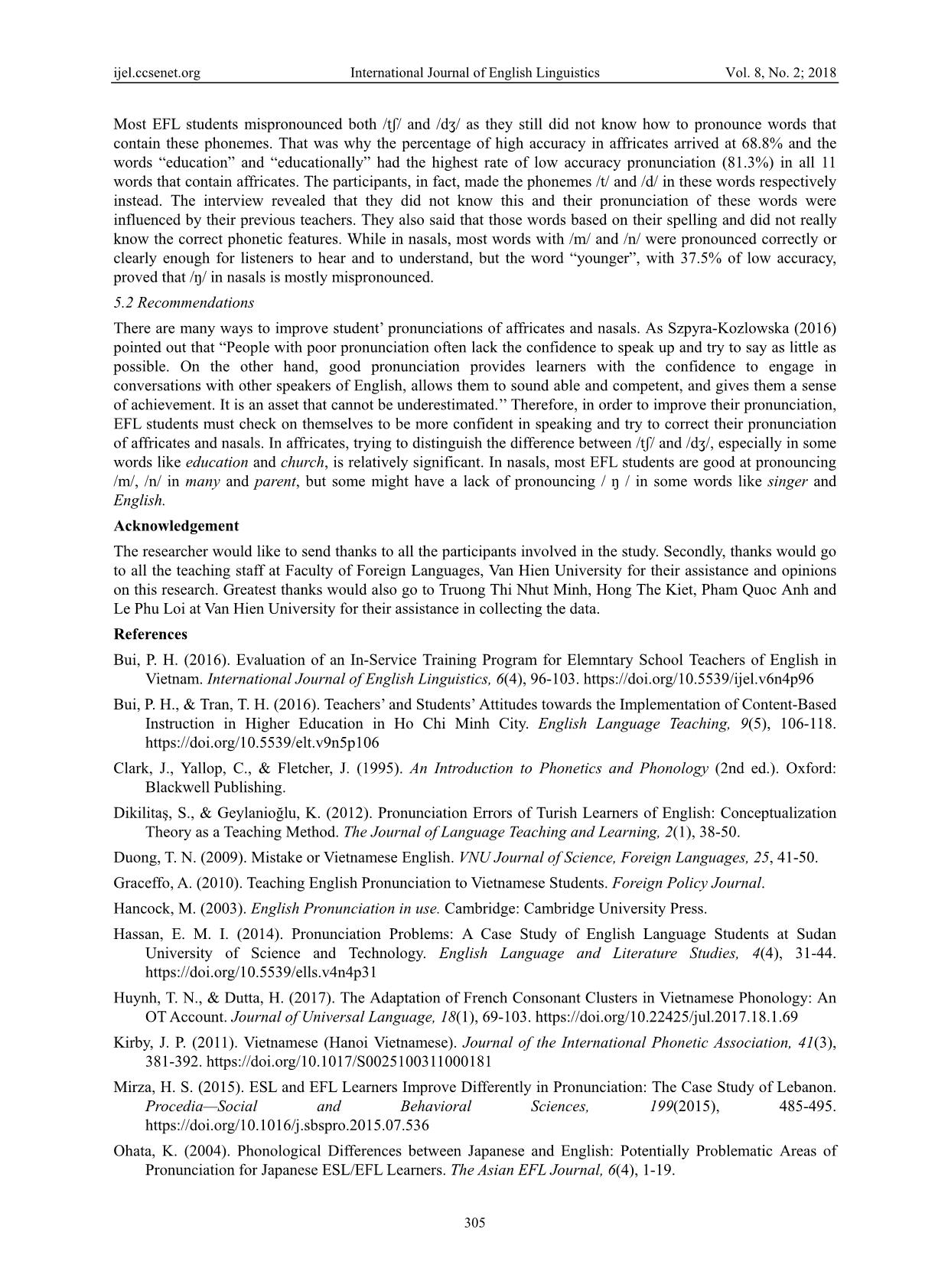
Trang 8
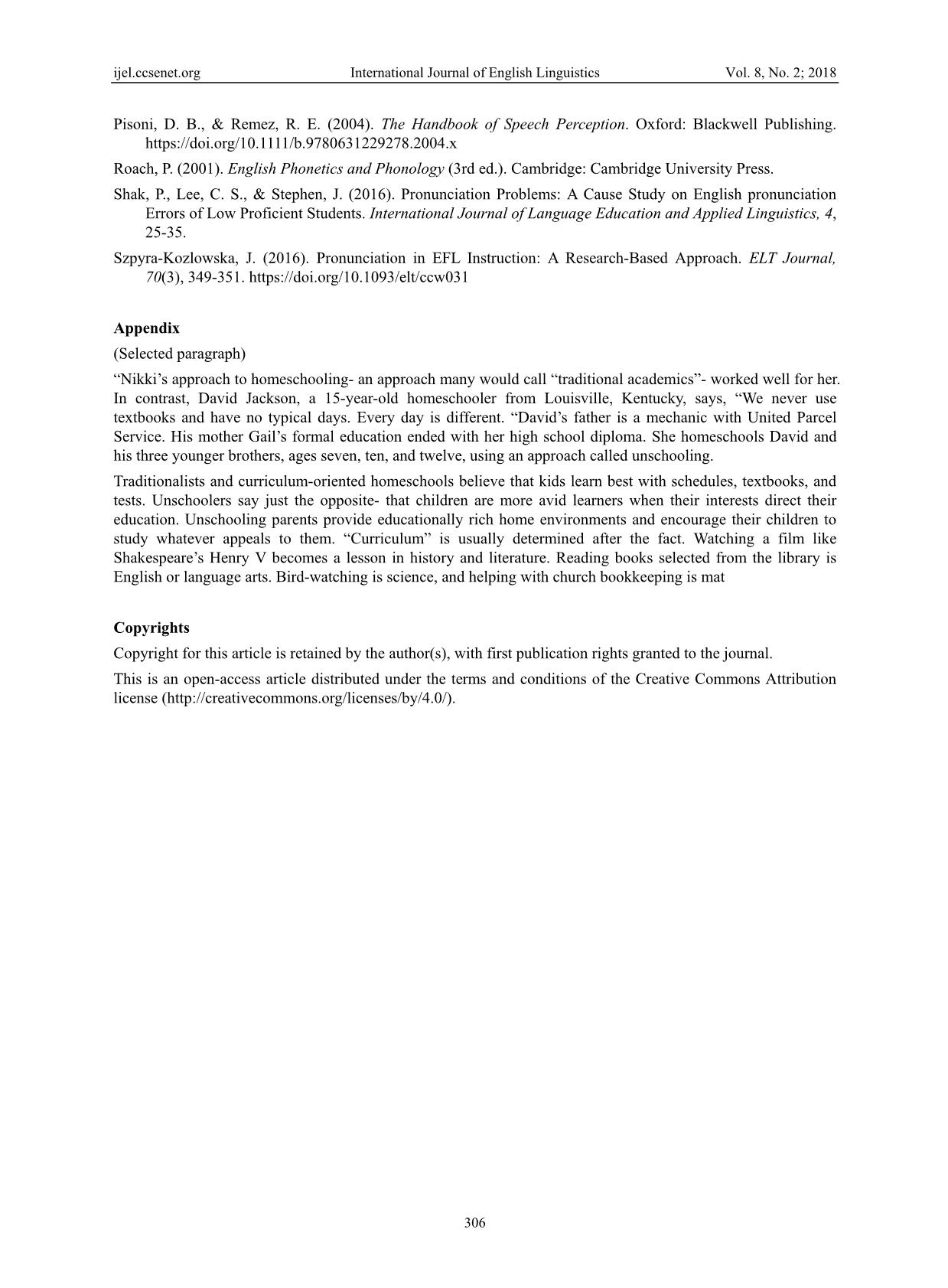
Trang 9
Tóm tắt nội dung tài liệu: An Analysis of Vietnamese EFL Students’ Pronunciation of English Affricates and Nasals
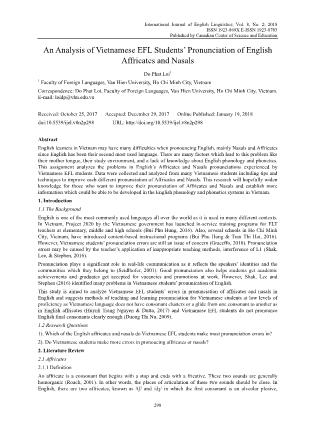
International Journal of English Linguistics; Vol. 8, No. 2; 2018 ISSN 1923-869X E-ISSN 1923-8703 Published by Canadian Center of Science and Education 298 An Analysis of Vietnamese EFL Students’ Pronunciation of English Affricates and Nasals Do Phat Loi1 1 Faculty of Foreign Languages, Van Hien University, Ho Chi Minh City, Vietnam Correspondence: Do Phat Loi, Faculty of Foreign Languages, Van Hien University, Ho Chi Minh City, Vietnam. E-mail: loidp@vhu.edu.vn Received: October 25, 2017 Accepted: December 29, 2017 Online Published: January 19, 2018 doi:10.5539/ijel.v8n2p298 URL: Abstract English learners in Vietnam may have many difficulties when pronouncing English, mainly Nasals and Affricates since English has been their second most used language. There are many factors which lead to this problem like their mother tongue, their study environment, and a lack of knowledge about English phonology and phonetics. This assignment analyzes the problems in English’s Affricates and Nasals pronunciations experienced by Vietnamese EFL students. Data were collected and analyzed from many Vietnamese students including tips and techniques to improve each different pronunciation of Affricates and Nasals. This research will hopefully widen knowledge for those who want to improve their pronunciation of Affricates and Nasals and establish more information which could be able to be developed in the English phonology and phonetics systems in Vietnam. 1. Introduction 1.1 The Background English is one of the most commonly used languages all over the world as it is used in many different contexts. In Vietnam, Project 2020 by the Vietnamese government has launched in-service training programs for ELT teachers at elementary, middle and high schools (Bui Phu Hung, 2016). Also, several schools in Ho Chi Minh City, Vietnam, have introduced content-based instructional programs (Bui Phu Hung & Tran Thi Hai, 2016). However, Vietnamese students’ pronunciation errors are still an issue of concern (Graceffo, 2010). Pronunciation errors may be caused by the teacher’s application of inappropriate teaching methods, interference of L1 (Shak, Lee, & Stephen, 2016). Pronunciation plays a significant role in real-life communication as it reflects the speakers’ identities and the communities which they belong to (Seidlhofer, 2001). Good pronunciation also helps students get academic achievements and graduates get accepted for vacancies and promotions at work. However, Shak, Lee and Stephen (2016) identified many problems in Vietnamese students’ pronunication of English. This study is aimed to analyze Vietnamese EFL students’ errors in pronunciation of affricates and nasals in English and suggests methods of teaching and learning pronunciation for Vietnamese students at low levels of proficiency as Vietnamese language does not have consonant clusters or a glide from one consonant to another as in English affricates (Huynh Trang Nguyen & Dutta, 2017) and Vietnamese EFL students do not pronounce English final consonants clearly enough (Duong Thi Nu, 2009). 1.2 Research Questions 1). Which of the English affricates and nasals do Vietnamese EFL students make most pronunciation errors in? 2). Do Vietnamese students make more errors in pronoucing affricates or nasals? 2. Literature Review 2.1 Affricates 2.1.1 Definition An affricate is a consonant that begins with a stop and ends with a fricative. These two sounds are generally homorganic (Roach, 2001). In other words, the places of articulation of these two sounds should be close. In English, there are two affricates, known as /tʃ/ and /dʒ/ in which the first consonant is an alveolar plosive, ijel.ccsenet.org International Journal of English Linguistics Vol. 8, No. 2; 2018 299 produced with a plosion, and the second is a post-alveolar fricative, produced with friction (Roach, 2001). Clark, Yallop & Fletcher, 1995, p. 65) believes that “There is almost always some degree of air turbulence (and hence friction) at the release of a stop. This is normally of such short duration that it counts as part of the release burst of the stop itself. However, when the release is strongly frictional and is extended in duration, it can be identified as a separate fricative phase of the articulation. A single complex segment of this kind, in which the articulators release an occlusion through a controlled fricative phase, is known as an affricate or affricative.” (Clark, Yallop, & Fletcher, 1995, p. 65) Pisoni & Remez (2005, p. 195) identify that the English affricates are an acoustic segment of oral alveolar stops and post-alveolar fricatives which are incorporated perceptually into a single phonological entity. This acoustic sequence is produced by the oral alveolar stop followed by the post-alveolar fricative. As a consequence, the English affricates contain acoustic cues for both stops and fricatives. That means the acoustic cues for the English affricates /tʃ/, /dʒ/ are more complicated than those of the English fricatives /ʃ/, /ʒ/. /tʃ/ is a voiceless consonant in which /t/ glides from alveolar to post-alveolar position, both /t/ and /ʃ/ are both voiceless consonants so /tʃ/ is a voiceless consonants. /tʃ/ can be spelled in the initial position, medial position and final position, usually spelled “ch”. Nonetheless, /dʒ/ is a voiced consonant which can be spelled in initial position, medial position and final position as “j”. The following table can illustrate this point. Table 1. English affricates Affricates Initial Medial Final /tʃ/ check /tʃɛk/ chat /tʃat/ teacher /ˈtitʃər/ kitchen /ˈkɪtʃən/ watch /ˈwɑtʃ/ catch /kætʃ/ /dʒ/ job /dʒɑb/ jam /dʒæm/ adjust /əˈdʒəst/ project /prəˈdʒɛkt/ fridge /frɪdʒ/ average /ˈævərɪdʒ/ Misra (2000, p. 78) identifies that /tʃ/ is a voiceless alveolar palatal affricate. This sound can be produced when ... scussions 32 recordings made by 32 the participants were analyzed with a focus on affricates and nasals at three main levels: high, intermediate and low. Table 4 and Table 5 illustrate this analysis of the participants’ pronunciation of each word in the text. The statistics show the numbers and percentages of pronunciation levels of accuracy of the mentioned words. Table 4. The analysis of affricates Accuracy level Word High Intermediate Low approach /əˈprəʊtʃ/ 34,4% (11/32) 40,6% (13/32) 25% (8/32) children /ˈtʃɪldrən/ 59,4% (19/32) 37,5% (12/32) 3,1% (1/32) education /ɛdʒʊˈkeɪʃən/ 15,6% (5/32) 3,1% (1/32) 81,3% (26/32) educationally /ˌɛdʒʊˈkeɪʃənəli/ 15,6% (5/32) 3,1% (1/32) 81,3% (26/32) rich /rɪtʃ/ 56,25% (18/32) 12,5% (4/32) 31,25% (10/32) encourage /ɛnˈkʌrɪdʒ/ 31,3% (10/32) 15,6% (5/32) 53,1% (17/32) watching /wɒtʃɪŋ/ 68,8% (22/32) 21,9% (7/32) 9,3% (3/32) literature /lɪtərətʃə/ 25% (8/32) 40,6% (13/32) 34,4% (11/32) language /laŋɡwɪdʒ/ 34,4% (11/32) 25% (8/32) 40,6% (13/32) bird-watching /bəːd-wɒtʃɪŋ/ 56,25% (18/32) 37,5% (12/32) 6,25% (2/32) church /tʃəːtʃ/ 34,4% (11/32) 43,8% (14/32) 21,8% (7/32) Table 5. The analysis of nasals Accuracy level High Intermediate Low nikki 96.9% (31/32) 0% (0/32) 3.1% (1/32) homeschooling /həʊmskuːlɪŋ/ 87.5% (28/32) 12.5% (4/32) 0% (0/32) an /ən/ 100% (32/32) 0% (0/32) 0% (0/32) many /mɛni/ 96.9% (31/32) 3.1% (1/32) 0% (0/32) traditional /trəˈdɪʃənəl/ 93.75% (30/32) 6.25% (2/32) 0% (0/32) academics /ˌækəˈdemɪk/ 100% (32/32) 0% (0/32) 0% (0/32) in /ɪn/ 100% (0/32) 0% (0/32) 0% (0/32) contrast /ˈkɑːntræst/ 84.4% (27/32) 15.6% (5/32) 0% (0/32) homeschooler /həʊmskuːlə/ 96.9% 0% 3.1% ijel.ccsenet.org International Journal of English Linguistics Vol. 8, No. 2; 2018 303 (31/32) (0/32) (1/32) from /frɒm/ 96.9% (31/32) 3.1% (1/32) 0% (0/32) kentucky 100% (32/32) 0% (0/32) 0% (0/32) never /ˈnevər/ 100% (32/32) 0% (0/32) 0% (0/32) no /nəʊ/ 100% (32/32) 0% (0/32) 0% (0/32) different /dɪfərənt/ 100% (32/32) 0% (0/32) 0% (0/32) mechanic /mə ˈkæ nɪk/ 65.6% (21/32) 31.3% (10/32) 3.1% (1/32) united /juːˈnʌɪtɪd/ 90.6% (29/32) 6.3% (2/32) 3.1% (1/32) mother /mʌðə/ 93.8% (30/32) 3.1% (1/32) 3.1% (1/32) formal /fɔːməl/ 90.6% (29/32) 9.4% (3/32) 0% (0/32) education /ɛdjʊˈkeɪʃən/ 90.6% (29/32) 9.4% (3/32) 0% (0/32) diploma /dɪˈpləʊmə/ 87.5% (28/32) 9.4% (3/32) 3.1% (1/32) homeschools /ˈhəʊmskuːlz/ 100% (32/32) 0% (0/32) 0% (0/32) and /ənd/ 100% (32/32) 0% (0/32) 0% (0/32) younger /ˈjʌnɡə/ 56.25% (18/32) 6.25% (2/32) 37.5% (12/32) seven /ˈsɛvən/ 96.9% (21/32) 0% (0/32) 3,1% (1/32) ten /tɛn/ 96.9% (21/32) 0% (0/32) 3,1% (1/32) using /juːzɪŋ/ 100% (32/32) 0% (0/32) 0% (0/32) unschooling /ʌnskuːlɪŋ/ 81.3% (26/32) 15.6% (5/32) 3.1% (1/32) traditionalist /trəˈdɪʃənəlɪst/ 93.8% (30/32) 3,1% (1/32) 3.1% (1/32) curriculum-oriented /kəˈrɪkjʊləm-ɔːrɪənt/ 65.6% (21/32) 25% (8/32) 9.4% (3/32) learn /ləːn/ 96.9% (31/32) 3.1% (1/32) 0% (0/32) unschooler /ʌnskuːlə/ 93.75% (30/32) 6.25% (2/32) 0% (0/32) children /tʃɪldrən/ 87.5% (28/32) 12.5% (4/32) 0% (0/32) more /mɔːri/ 90.6% (29/32) 6.3% (2/32) 3.1% (1/32) learners /ˈləːnəz/ 96.9% (31/32) 3.1% (1/32) 0% (0/32) when /wɛn/ 100% (32/32) 0% (0/32) 0% (0/32) interest /ɪntərɪst/ 78.1% (25/32) 21.9% (7/32) 0% (0/32) parent /pɛːrənt/ 87.5% (28/32) 3.1% (1/32) 9.4% (3/32) educationally /ˌɛdʒʊˈkeɪʃənəli/ 78.1% (25/32) 12.5% (4/32) 9.4% (3/32) home /həʊm/ 96.9% (31/32) 0% (0/32) 3.1% (1/32) environment /ɛnˈvʌɪrənmənt/ 75% (24/32) 15.6% (5/32) 9.4% (3/32) encourage /ɛnˈkʌrɪdʒ/ 75% (24/32) 18.75% (6/32) 6.25% (2/32) them /ðɛm/ 100% (32/32) 0% (0/32) 0% (0/32) curriculum /kəˈrɪkjʊləm/ 93.75% (30/32) 6.25% (2/32) 0% (0/32) encourage /ɛnˈkʌrɪdʒ/ 75% (24/32) 18.75% (6/32) 6.25% (2/32) them /ðɛm/ 100% (32/32) 0% (0/32) 0% (0/32) curriculum /kəˈrɪkjʊləm/ 93.75% (30/32) 6.25% (2/32) 0% (0/32) ijel.ccsenet.org International Journal of English Linguistics Vol. 8, No. 2; 2018 304 determinded /dɪˈtəːmɪnd/ 59.3% (19/32) 31.3% (10/32) 9.4% (3/32) watching /wɒtʃɪŋ/ 96.9% (31/32) 0% (0/32) 3.1% (1/32) film /fɪlm/ 87.5% (2/32) 12.5% (4/32) 0% (0/32) henry 90.6% (29/32) 3.1% (1/32) 6.3% (2/32) become /bɪˈkʌm/ 100% (32/32) 0% (0/32) 0% (0/32) lesson /lɛsən/ 96.9% (31/32) 3.1% (1/32) 0% (0/32) reading /ri:dɪŋ/ 90.6% (29/32) 9.4% (3/32) 0% (0/32) English /ɪŋɡlɪʃ/ 90.6% (29/32) 6.3% (2/32) 3.1% (1/32) language /laŋɡwɪdʒ/ 84.3% (27/32) 9.4% (3/32) 6.3% (2/32) bird-watching /bəːd-wɒtʃɪŋ/ 84.4% (27/32) 15.6% (5/32) 0% (0/32) science /sʌɪəns/ 84.4% (27/32) 9.4% (3/32) 6.2% (2/32) helping /hɛlpɪŋ/ 81.3% (26/32) 18.7% (6/32) 0% (0/32) bookkeeping /ˈbʊkkiːpɪŋ/ 84.4% (27/32) 12.5% (4/32) 3.1% (1/32) math /maθ/ 87.5% (28/32) 9.4% (3/32) 3.1% (1/32) opportunities /ɒpəˈtjuːnɪtiz/ 68.8% (22/32) 28.1% (9/32) 3.1% (1/32) endless /ɛndləs/ 87.5% (28/32) 9.4% (3/32) 3.1% (1/32) determinded /dɪˈtəːmɪnd/ 59.3% (19/32) 31.3% (10/32) 9.4% (3/32) watching /wɒtʃɪŋ/ 96.9% (31/32) 0% (0/32) 3.1% (1/32) film /fɪlm/ 87.5% (2/32) 12.5% (4/32) 0% (0/32) henry 90.6% (29/32) 3.1% (1/32) 6.3% (2/32) become /bɪˈkʌm/ 100% (32/32) 0% (0/32) 0% (0/32) lesson /lɛsən/ 96.9% (31/32) 3.1% (1/32) 0% (0/32) reading /ri:dɪŋ/ 90.6% (29/32) 9.4% (3/32) 0% (0/32) English /ɪŋɡlɪʃ/ 90.6% (29/32) 6.3% (2/32) 3.1% (1/32) language /laŋɡwɪdʒ/ 84.3% (27/32) 9.4% (3/32) 6.3% (2/32) bird-watching /bəːd-wɒtʃɪŋ/ 84.4% (27/32) 15.6% (5/32) 0% (0/32) science /sʌɪəns/ 84.4% (27/32) 9.4% (3/32) 6.2% (2/32) helping /hɛlpɪŋ/ 81.3% (26/32) 18.7% (6/32) 0% (0/32) bookkeeping /ˈbʊkkiːpɪŋ/ 84.4% (27/32) 12.5% (4/32) 3.1% (1/32) math /maθ/ 87.5% (28/32) 9.4% (3/32) 3.1% (1/32) opportunities /ɒpəˈtjuːnɪtiz/ 68.8% (22/32) 28.1% (9/32) 3.1% (1/32) endless /ɛndləs/ 87.5% (28/32) 9.4% (3/32) 3.1% (1/32) The analysis shows that the participants made more errors with the pronunciation of affricates than nasals. In particular, the affricates in the final position were often skipped or omitted by the participants. The participants also made more errors with the pronunciation of /ŋ/ than the other nasals. 5. Conclusions 5.1 General Conclusions In conclusion, from many records collected, there are many mistakes at the way each EFL student pronounced. ijel.ccsenet.org International Journal of English Linguistics Vol. 8, No. 2; 2018 305 Most EFL students mispronounced both /tʃ/ and /dʒ/ as they still did not know how to pronounce words that contain these phonemes. That was why the percentage of high accuracy in affricates arrived at 68.8% and the words “education” and “educationally” had the highest rate of low accuracy pronunciation (81.3%) in all 11 words that contain affricates. The participants, in fact, made the phonemes /t/ and /d/ in these words respectively instead. The interview revealed that they did not know this and their pronunciation of these words were influenced by their previous teachers. They also said that those words based on their spelling and did not really know the correct phonetic features. While in nasals, most words with /m/ and /n/ were pronounced correctly or clearly enough for listeners to hear and to understand, but the word “younger”, with 37.5% of low accuracy, proved that /ŋ/ in nasals is mostly mispronounced. 5.2 Recommendations There are many ways to improve student’ pronunciations of affricates and nasals. As Szpyra-Kozlowska (2016) pointed out that “People with poor pronunciation often lack the confidence to speak up and try to say as little as possible. On the other hand, good pronunciation provides learners with the confidence to engage in conversations with other speakers of English, allows them to sound able and competent, and gives them a sense of achievement. It is an asset that cannot be underestimated.’’ Therefore, in order to improve their pronunciation, EFL students must check on themselves to be more confident in speaking and try to correct their pronunciation of affricates and nasals. In affricates, trying to distinguish the difference between /tʃ/ and /dʒ/, especially in some words like education and church, is relatively significant. In nasals, most EFL students are good at pronouncing /m/, /n/ in many and parent, but some might have a lack of pronouncing / ŋ / in some words like singer and English. Acknowledgement The researcher would like to send thanks to all the participants involved in the study. Secondly, thanks would go to all the teaching staff at Faculty of Foreign Languages, Van Hien University for their assistance and opinions on this research. Greatest thanks would also go to Truong Thi Nhut Minh, Hong The Kiet, Pham Quoc Anh and Le Phu Loi at Van Hien University for their assistance in collecting the data. References Bui, P. H. (2016). Evaluation of an In-Service Training Program for Elemntary School Teachers of English in Vietnam. International Journal of English Linguistics, 6(4), 96-103. https://doi.org/10.5539/ijel.v6n4p96 Bui, P. H., & Tran, T. H. (2016). Teachers’ and Students’ Attitudes towards the Implementation of Content-Based Instruction in Higher Education in Ho Chi Minh City. English Language Teaching, 9(5), 106-118. https://doi.org/10.5539/elt.v9n5p106 Clark, J., Yallop, C., & Fletcher, J. (1995). An Introduction to Phonetics and Phonology (2nd ed.). Oxford: Blackwell Publishing. Dikilitaş, S., & Geylanioğlu, K. (2012). Pronunciation Errors of Turish Learners of English: Conceptualization Theory as a Teaching Method. The Journal of Language Teaching and Learning, 2(1), 38-50. Duong, T. N. (2009). Mistake or Vietnamese English. VNU Journal of Science, Foreign Languages, 25, 41-50. Graceffo, A. (2010). Teaching English Pronunciation to Vietnamese Students. Foreign Policy Journal. Hancock, M. (2003). English Pronunciation in use. Cambridge: Cambridge University Press. Hassan, E. M. I. (2014). Pronunciation Problems: A Case Study of English Language Students at Sudan University of Science and Technology. English Language and Literature Studies, 4(4), 31-44. https://doi.org/10.5539/ells.v4n4p31 Huynh, T. N., & Dutta, H. (2017). The Adaptation of French Consonant Clusters in Vietnamese Phonology: An OT Account. Journal of Universal Language, 18(1), 69-103. https://doi.org/10.22425/jul.2017.18.1.69 Kirby, J. P. (2011). Vietnamese (Hanoi Vietnamese). Journal of the International Phonetic Association, 41(3), 381-392. https://doi.org/10.1017/S0025100311000181 Mirza, H. S. (2015). ESL and EFL Learners Improve Differently in Pronunciation: The Case Study of Lebanon. Procedia—Social and Behavioral Sciences, 199(2015), 485-495. https://doi.org/10.1016/j.sbspro.2015.07.536 Ohata, K. (2004). Phonological Differences between Japanese and English: Potentially Problematic Areas of Pronunciation for Japanese ESL/EFL Learners. The Asian EFL Journal, 6(4), 1-19. ijel.ccsenet.org International Journal of English Linguistics Vol. 8, No. 2; 2018 306 Pisoni, D. B., & Remez, R. E. (2004). The Handbook of Speech Perception. Oxford: Blackwell Publishing. https://doi.org/10.1111/b.9780631229278.2004.x Roach, P. (2001). English Phonetics and Phonology (3rd ed.). Cambridge: Cambridge University Press. Shak, P., Lee, C. S., & Stephen, J. (2016). Pronunciation Problems: A Cause Study on English pronunciation Errors of Low Proficient Students. International Journal of Language Education and Applied Linguistics, 4, 25-35. Szpyra-Kozlowska, J. (2016). Pronunciation in EFL Instruction: A Research-Based Approach. ELT Journal, 70(3), 349-351. https://doi.org/10.1093/elt/ccw031 Appendix (Selected paragraph) “Nikki’s approach to homeschooling- an approach many would call “traditional academics”- worked well for her. In contrast, David Jackson, a 15-year-old homeschooler from Louisville, Kentucky, says, “We never use textbooks and have no typical days. Every day is different. “David’s father is a mechanic with United Parcel Service. His mother Gail’s formal education ended with her high school diploma. She homeschools David and his three younger brothers, ages seven, ten, and twelve, using an approach called unschooling. Traditionalists and curriculum-oriented homeschools believe that kids learn best with schedules, textbooks, and tests. Unschoolers say just the opposite- that children are more avid learners when their interests direct their education. Unschooling parents provide educationally rich home environments and encourage their children to study whatever appeals to them. “Curriculum” is usually determined after the fact. Watching a film like Shakespeare’s Henry V becomes a lesson in history and literature. Reading books selected from the library is English or language arts. Bird-watching is science, and helping with church bookkeeping is mat Copyrights Copyright for this article is retained by the author(s), with first publication rights granted to the journal. This is an open-access article distributed under the terms and conditions of the Creative Commons Attribution license (
File đính kèm:
 an_analysis_of_vietnamese_efl_students_pronunciation_of_engl.pdf
an_analysis_of_vietnamese_efl_students_pronunciation_of_engl.pdf

